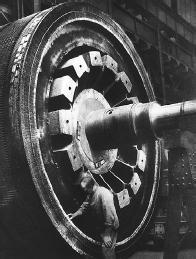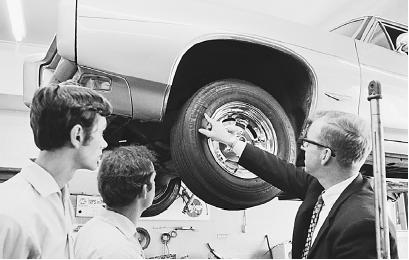Mechanical Advantage and Simple Machines - How it works

Machines and Classical Mechanics
There are four known types of force in the universe: gravitational, electromagnetic, weak nuclear, and strong nuclear. This was the order in which the forces were identified, and the number of machines that use each force descends in the same order. The essay that follows will make little or no reference to nuclear-powered machines. Somewhat more attention will be paid to electrical machines; however, to trace in detail the development of forces in that context would require a new and somewhat cumbersome vocabulary.
Instead, the machines presented for consideration here depend purely on gravitational force and the types of force explainable purely in a gravitational framework. This is the realm of classical physics, a term used to describe the studies of physicists from the time of Galileo Galilei (1564-1642) to the end of the nineteenth century. During this era, physicists were primarily concerned with large-scale interactions that were easily comprehended by the senses, as opposed to the atomic behaviors that have become the subject of modern physics.
Late in the classical era, the Scottish physicist James Clerk Maxwell (1831-1879)—building on the work of many distinguished predecessors—identified electromagnetic force. For most of the period, however, the focus was on gravitational force and mechanics, or the study of matter, motion, and forces. Likewise, the majority of machines invented and built during most of the classical period worked according to the mechanical principles of plain gravitational force.
This was even true to some extent with the steam engine, first developed late in the seventeenth century and brought to fruition by Scotland's James Watt (1736-1819.) Yet the steam engine, though it involved ordinary mechanical processes in part, represented a new type of machine, which used thermal energy. This is also true of the internal-combustion engine; yet both steam-and gas-powered engines to some extent borrowed the structure of the hydraulic press, one of the three basic types of machine. Then came the development of electronic power, thanks to Thomas Edison (1847-1931) and others, and machines became increasingly divorced from basic mechanical laws.

The heyday of classical mechanics—when classical studies in mechanics represented the absolute cutting edge of experimentation—was in the period from the beginning of the seventeenth century to the beginning of the nineteenth. One figure held a dominant position in the world of physics during those two centuries, and indeed was the central figure in the history of physics between Galileo and Albert Einstein (1879-1955). This was Sir Isaac Newton (1642-1727), who discerned the most basic laws of physical reality—laws that govern everyday life, including the operation of simple machines.
Newton and his principles are essential to the study that follows, but one other figure deserves "equal billing": the Greek mathematician, physicist, and inventor Archimedes (c. 287-212 B.C. ). Nearly 2,000 years before Newton, Archimedes explained and improved a number of basic machines, most notably the lever. Describing the powers of the lever, he is said to have promised, "Give me a lever long enough and a place to stand, and I will move the world." This he demonstrated, according to one story, by moving a fully loaded ship single-handedly with the use of a lever, while remaining seated some distance away.
Mechanical Advantage
A common trait runs through all forms of machinery: mechanical advantage, or the ratio of force output to force input. In the case of the lever, a simple machine that will be discussed in detail below, mechanical advantage is high. In some machines, however, mechanical advantage is actually less than 1, meaning that the resulting force is less than the applied force.
This does not necessarily mean that the machine itself has a flaw; on the contrary, it can mean that the machine has a different purpose than that of a lever. One example of this is the screw: a screw with a high mechanical advantage—that is, one that rewarded the user's input of effort by yielding an equal or greater output—would be useless. In this case, mechanical advantage could only be achieved if the screw backed out from the hole in which it had been placed, and that is clearly not the purpose of a screw.
Here a machine offers an improvement in terms of direction rather than force; likewise with scissors or a fishing rod, both of which will be discussed below, an improvement with regard to distance or range of motion is bought at the expense of force. In these and many more cases, mechanical advantage alone does not measure the benefit. Thus, it is important to keep in mind what was previously stated: a machine either increases force output, or changes the force's distance or direction of operation.
Most machines, however, work best when mechanical advantage is maximized. Yet mechanical advantage—whether in theoretical terms or real-life instances—can only go so high, because there are factors that limit it. For one thing, the operator must give some kind of input to yield an output; furthermore, in most situations friction greatly diminishes output. Hence, in the operation of a car, for instance, one-quarter of the vehicle's energy is expended simply on overcoming the resistance of frictional forces.
For centuries, inventors have dreamed of creating a mechanism with an almost infinite mechanical advantage. This is the much-sought-after "perpetual motion machine," that would only require a certain amount of initial input; after that, the machine would simply run on its own forever. As output compounded over the years, its ratio to input would become so high that the figure for mechanical advantage would approach infinity.
A number of factors, most notably the existence of friction, prevent the perpetual motion machine from becoming anything other than a pipe dream. In outer space, however, the near-absence of friction makes a perpetual motion machine viable: hence, a space probe launched from Earth can travel indefinitely unless or until it enters the gravitational field of some other body in deep space.
The concept of a perpetual motion machine, at least on Earth, is only an idealization; yet idealization does have its place in physics. Physicists discuss most concepts in terms of an idealized state. For instance, when illustrating the acceleration due to gravity experienced by a body in free fall, it is customary to treat such an event as though it were taking place under conditions divorced from reality. To consider the effects of friction, air resistance, and other factors on the body's fall would create an impossibly complicated problem—yet real-world situations are just that complicated.
In light of this tendency to discuss physical processes in idealized terms, it should be noted that there are two types of mechanical advantage: theoretical and actual. Efficiency, as applied to machines in its most specific scientific sense, is the ratio of actual to theoretical mechanical advantage. This in some ways resembles the formula for mechanical advantage itself: once again, what is being measured is the relationship between "output" (the real behavior of the machine) and "input" (the planned behavior of the machine).
As with other mechanical processes, the actual mechanical advantage of a machine is a much more complicated topic than the theoretical mechanical advantage. The gulf between the two, indeed, is enormous. It would be almost impossible to address the actual behavior of machines within an environment framework that includes complexities such as friction.
Each real-world framework—that is, each physical event in the real world—is just a bit different from every other one, due to the many varieties of factors involved. By contrast, the idealized machines of physics problems behave exactly the same way in one imaginary situation after another, assuming outside conditions are the same. Therefore, the only form of mechanical advantage that a physicist can easily discuss is theoretical. For that reason, the term "efficiency" will henceforth be used as a loose synonym for mechanical advantage—even though the technical definition is rather different.
Types of Machines
The term "simple machine" is often used to describe the labor-saving devices known to the ancient world, most of which consisted of only one or two essential parts. Historical sources vary regarding the number of simple machines, but among the items usually listed are levers, pulleys, winches, wheels and axles, inclined planes, wedges, and screws. The list, though long, can actually be reduced to just two items: levers and inclined planes. All the items listed after the lever and before the inclined plane—including the wheel and axle—are merely variations on the lever. The same goes for the wedge and the screw, with regard to the inclined plane.
In fact, all machines are variants on three basic devices: the lever, the inclined plane, and the hydraulic press. Each transmits or modifies force or torque, producing an improvement in force, distance, or direction. The first two, which will receive more attention here, share several aspects not true of the third. First of all, the lever and the inclined plane originated at the beginning of civilization, whereas the hydraulic press is a much more recent invention.
The lever appeared as early as 5000 B.C. in the form of a simple balance scale, and within a few thousand years, workers in the Near East and India were using a crane-like lever called the shaduf to lift containers of water. The shaduf, introduced in Mesopotamia in about 3000 B.C. , consisted of a long wooden pole that pivoted on two upright posts. At one end of the lever was a counterweight, and at the other a bucket. The operator pushed down on the pole to fill the bucket with water, and then used the counter-weight to assist in lifting the bucket.
The inclined plane made its appearance in the earliest days of civilization, when the Egyptians combined it with rollers in the building of their monumental structures, the pyramids. Modern archaeologists generally believe that Egyptian work gangs raised the huge stone blocks of the pyramids through the use of sloping earthen ramps. These were most probably built up alongside the pyramid itself, and then removed when the structure was completed.

In contrast to the distant origins of the other two machines, the hydraulic press seems like a mere youngster. Also, the first two clearly arose as practical solutions first: by the time Archimedes achieved a conceptual understanding of these machines, they had been in use a long, long time. The hydraulic press, on the other hand, first emerged from the theoretical studies of the brilliant French mathematician and physicist Blaise Pascal (1623-1662.) Nearly 150 years passed before the English inventor Joseph Bramah (1748-1814) developed a workable hydraulic press in 1796, by which time Watt had already introduced his improved steam engine. The Industrial Revolution was almost underway.